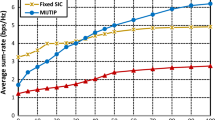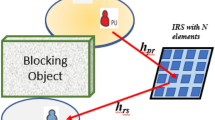Abstract
With the continuously increasing demand for broadband applications and services, underlay cognitive satellite-terrestrial networks, enabling to accommodate better wireless services within the scarce spectrum, have attracted tremendous attentions recently. In this network, satellite communications are allowed to operate in the frequency bands allocated to terrestrial networks under the interference constraints imposed by terrestrial network, which may lead to a performance degradation of the satellite network. To guarantee the performance of the primary terrestrial network as well as the secondary satellite network, we introduce the cooperation into cognitive satellite-terrestrial networks and investigate the performance of the new framework, i.e., cognitive satellite-terrestrial cooperative network (CSTCN). Specifically, by restricting the transmit power of satellite communications with interference power constraints imposed by terrestrial communications, we firstly obtain the received signal-to-interference-plus-noise ratio (SINR) of the considered network. Moreover, by employing the moment generating function (MGF) approach, closed-form expressions for symbol error rate (SER) and outage probability (OP) of the considered cognitive network are derived. The analytical results obtained in this paper can provide theoretical support for optimizing the performance of satellite-terrestrial networks.
Similar content being viewed by others
References
Evans B, Werner M, Lutz E, et al. Integration of satellite and terrestrial systems in future multimedia communications. IEEE Wirel Commun, 2005, 12: 72–80
Sadek M, Aissa S. Personal satellite communication: technologies and challenges. IEEE Wirel Commun, 2012, 19: 28–35
Ruan Y H, Li Y Z, Wang C X, et al. Energy efficient adaptive transmissions in integrated satellite-terrestrial networks with SER constraints. IEEE Trans Wirel Commun, 2018, 17: 210–222
Li H J, Yin H, Dong F H, et al. Capacity upper bound analysis of the hybrid satellite terrestrial communication systems. IEEE Commun Lett, 2016, 20: 2402–2405
Zhang J X, Evans B, Imran M A, et al. Green hybrid satellite terrestrial networks: fundamental trade-off analysis. In: Proceedings of IEEE Vehicular Technology Conference (VTC’16), Nanjing, 2016
Arti M K, Jindal S K. OSTBC transmission in shadowed-Rician land mobile satellite links. IEEE Trans Veh Technol, 2016, 65: 5771–5777
Khan A H, Imran M A, Evans B G. Semi-adaptive beamforming for OFDM based hybrid terrestrial-satellite mobile system. IEEE Trans Wirel Commun, 2012, 11: 3424–3433
Sithamparanathan K, de Nardis L, Di Benedetto M G, et al. Cognitive satellite terrestrial radios. In: Proceedings of IEEE Global Communications Conference (GLOBECOM’10), Miami, 2010
Ge X H, Tu S, Mao G Q, et al. 5G ultra-dense cellular networks. IEEE Wirel Commun, 2016, 23: 72–79
Wang C X, Wu S B, Bai L, et al. Recent advances and future challenges for massive MIMO channel measurements and models. Sci China Inf Sci, 2016, 59: 021301
Höyhtyä M, kyröläinen J, Hulkkonen A, et al. Application of cognitive radio techniques to satellite communication. In: Proceedings of IEEE International Symposium on Dynamic Spectrum Access Networks (DYSPAN’12), Bellevue, 2012. 540–551
Sharma S K, Chatzinotas S, Ottersten B. Satellite cognitive communications: interference modeling and techniques selection. In: Proceedings of IEEE Advanced Satellite Multimedia Systems Conference (ASMS) and Signal Processing for Space Communications Workshop (SPSC), Baiona, 2012. 111–118
Haider F, Wang C X, Haas H, et al. Spectral and energy efficiency analysis for cognitive radio networks. IEEE Trans Wirel Commun, 2015, 14: 2969–2980
Icolari V, Guidotti A, Tarchi D, et al. An interference estimation technique for satellite cognitive radio systems. In: Proceedings of IEEE International Conference on Communications (ICC’15), London, 2015. 892–897
Kuang L L, Chen X, Jiang C X, et al. Radio resource management in future terrestrial-satellite communication networks. IEEE Wirel Commun, 2017, 24: 81–87
Ruan Y H, Li Y Z, Wang C X, et al. Outage performance of integrated satellite-terrestrial networks with hybrid CCI. IEEE Commun Lett, 2017, 21: 1545–1548
Lagunas E, Sharma S K, Maleki S, et al. Resource allocation for cognitive satellite communications with incumbent terrestrial networks. IEEE Trans Cogn Commun Netw, 2015, 1: 305–317
Guidolin F, Nekovee M, Badia L, et al. A cooperative scheduling algorithm for the coexistence of fixed satellite services and 5G cellular network. In: Proceedings of IEEE International Conference on Communications (ICC’15), London, 2015. 1322–1327
Zhang W S, Wang C X, Chen D, et al. Energy-spectral efficiency tradeoff in cognitive radio networks. IEEE Trans Veh Technol, 2016, 65: 2208–2218
An K, Ouyang J, Lin M, et al. Outage analysis of multi-antenna cognitive hybrid satellite-terrestrial relay networks with beamforming. IEEE Commun Lett, 2015, 19: 1157–1160
Bhatnagar M R, Arti M K. Performance analysis of AF based hybrid satellite-terrestrial cooperative network over generalized fading channels. IEEE Commun Lett, 2013, 17: 1912–1915
Sreng S, Escrig B, Boucheret M L. Exact symbol error probability of hybrid/integrated satellite-terrestrial cooperative network. IEEE Trans Wirel Commun, 2013, 12: 1310–1319
Ruan Y H, Li Y Z, Zhang R, et al. Performance analysis of hybrid satellite-terrestrial cooperative networks with distributed alamouti code. In: Proceedings of IEEE Vehicular Technology Conference (VTC’16), Nanjing, 2016
Chun L. A statistical model for a land mobile satellite link. IEEE Trans Veh Technol, 1985, 34: 122–127
Peppas K P. Accurate closed-form approximations to generalised-K sum distributions and applications in the performance analysis of equal-gain combining receivers. IET Commun, 2011, 5: 982–989
Ruan Y H, Li Y Z, Wang C X, et al. Effective capacity analysis for underlay cognitive satellite-terrestrial networks. In: Proceedings of IEEE International Conference on Communications (ICC’17), Paris, 2017
Gradshteyn I S, Ryzhik I M. Table of Integrals, Series, and Products. 6th ed. Orlando: Academic Press, 2000
Simon M K, Alouini M S. Digital Communication over Fading Channels. Hoboken: John Wiley & Sons, 2005
Simon M K, Alouini M S, Ko Y C. Outage probability of diversity systems over generalized fading channels. IEEE Trans Commun, 2000, 48: 1783–1787
Adamchik V S, Marichev O I. The algorithm for calculating integrals of hypergeometric type functions and its realization in reduce systems. In: Proceedings of International Conference Symposium on Algebraic Computing, Tokyo, 1990. 212–224
Ikki S S, Aissa S. Performance analysis of two-way amplify-and-forward relaying in the presence of co-channel interferences. IEEE Trans Commun, 2012, 60: 933–939
Mckay M R, Zanella A, Collings I B, et al. Error probability and SINR analysis of optimum combining in rician fading. IEEE Trans Commun, 2009, 57: 676–687
Acknowledgements
This work was supported by National Key R&D Program of China (Grant No. 2016YFB1200202), National Natural Science Foundation of China (Grant No. 61771365), Natural Science Foundation of Shaanxi Province (Grant No. 2017JZ022), Programme of Introducing Talents of Discipline to Universities (111 Project) (Grant No. B08038), EU H2020 RISE TESTBED Project (Grant No. 734325), and EPSRC TOUCAN Project (Grant No. EP/L020009/1).
Author information
Authors and Affiliations
Corresponding author
Rights and permissions
About this article
Cite this article
Ruan, Y., Li, Y., Wang, CX. et al. Performance evaluation for underlay cognitive satellite-terrestrial cooperative networks. Sci. China Inf. Sci. 61, 102306 (2018). https://doi.org/10.1007/s11432-017-9362-5
Received:
Revised:
Accepted:
Published:
DOI: https://doi.org/10.1007/s11432-017-9362-5




